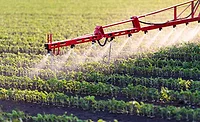USDA Finds Pesticide Residues below EPA Tolerances in 99 Percent of U.S. Fruit, Vegetable Samples

Credit: Scott Warman (scottiewarman) via Unsplash
The U.S. Department of Agriculture’s Agricultural Marketing Service (USDA’s AMS) has found the majority of fruits and vegetables in the U.S. to contain pesticide residues below the tolerances established by the U.S. Environmental Protection Agency (EPA), according to the agency’s Pesticide Data Program (PDP) summary for 2021.
To collect data for its annual report, PDP works with state agencies representing all census regions of the country and nearly half of the U.S. population. In 2021, analyzed samples were collected in California, Colorado, Florida, Maryland, Michigan, New York, Ohio, Texas, and Washington.
PDP commodity sampling is based on a statistical design that ensures collected data are reliable for use in exposure assessments and can be used to draw various conclusions about the U.S. food supply. The pesticides and commodities to be included each year in the sampling are selected based on EPA data needs, and the types and amounts of food consumed by infants and children are considered. The number of samples collected by each state is apportioned according to that state’s population. Samples are randomly chosen close to the time and point of consumption (i.e., distribution centers rather than at the farm gate) and reflect what is typically available to the consumer throughout the year. Samples are selected without regard to country of origin, variety, growing season, or organic labeling.
Fresh and processed fruit and vegetables accounted for 94 percent of the total 10,127 samples collected in 2021. Fresh and processed fruit and vegetables tested during 2021 included: blueberries (fresh and frozen), broccoli, cantaloupe, carrots, cauliflower, celery, eggplant, grape juice, green beans, peaches (fresh and frozen), pears, plums, summer squash, sweet bell peppers, tangerines, watermelon, and winter squash. Corn grain and butter were also tested during 2021, accounting for 4.1 and 1.7 percent of the samples collected in 2021, respectively. Domestic samples accounted for 67.8 percent of the samples, while 30.8 percent were imports, 0.9 percent were of mixed national origin, and 0.5 percent were of unknown origin.
In 2021, over 99 percent of the samples tested had residues below the tolerances established by EPA, with 24.0 percent having no detectable residue. Residues exceeding tolerances were detected in 0.53 percent (54 samples) of the total samples tested. Of these 54 samples, 29 were domestic (53.7 percent), 24 were imported (44.4 percent), and one was of unknown origin (1.9 percent).
Residues with no established tolerance were found in 3.7 percent (374 samples) of the total samples. Of these 374 samples, 220 were domestic (58.8 percent), 150 were imported (40.1 percent), and 4 were of unknown origin (1.1 percent).
Because PDP data are used for risk assessments, PDP laboratory methods are geared to detect very low levels of pesticide residues, even when those levels are well below the tolerances established by EPA. Prior to testing, PDP analysts washed samples for 15 to 20 seconds with gently running cold water as a consumer may do; no chemicals, soaps, or any special washes were used.
COVID-19-related closures disrupted PDP sampling in the early months of 2021, which may have impacted the seasonal observations within the data for the year. COVID-19-related delays also occurred in PDP laboratory operations in 2021.
Looking for quick answers on food safety topics?
Try Ask FSM, our new smart AI search tool.
Ask FSM →








